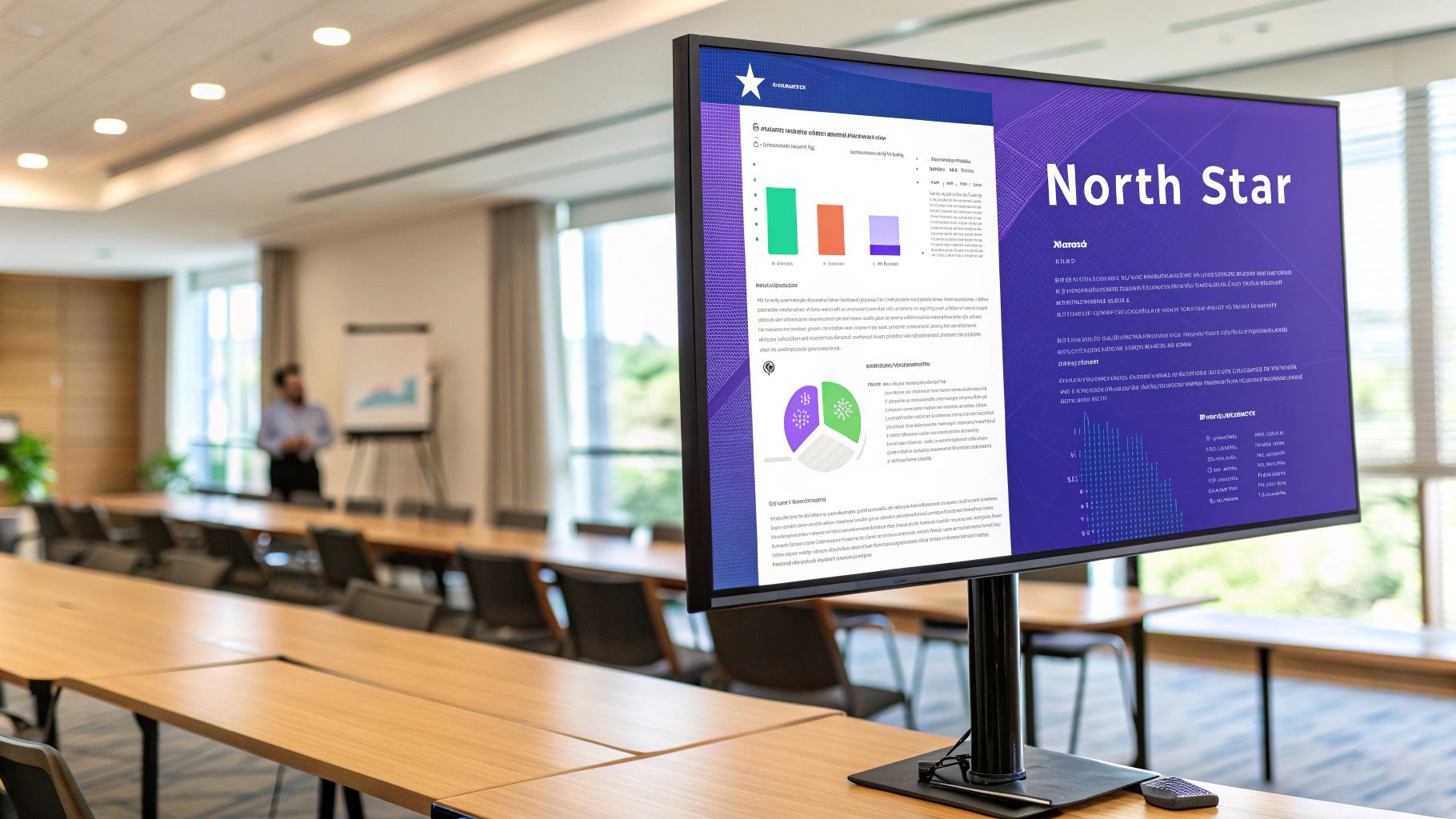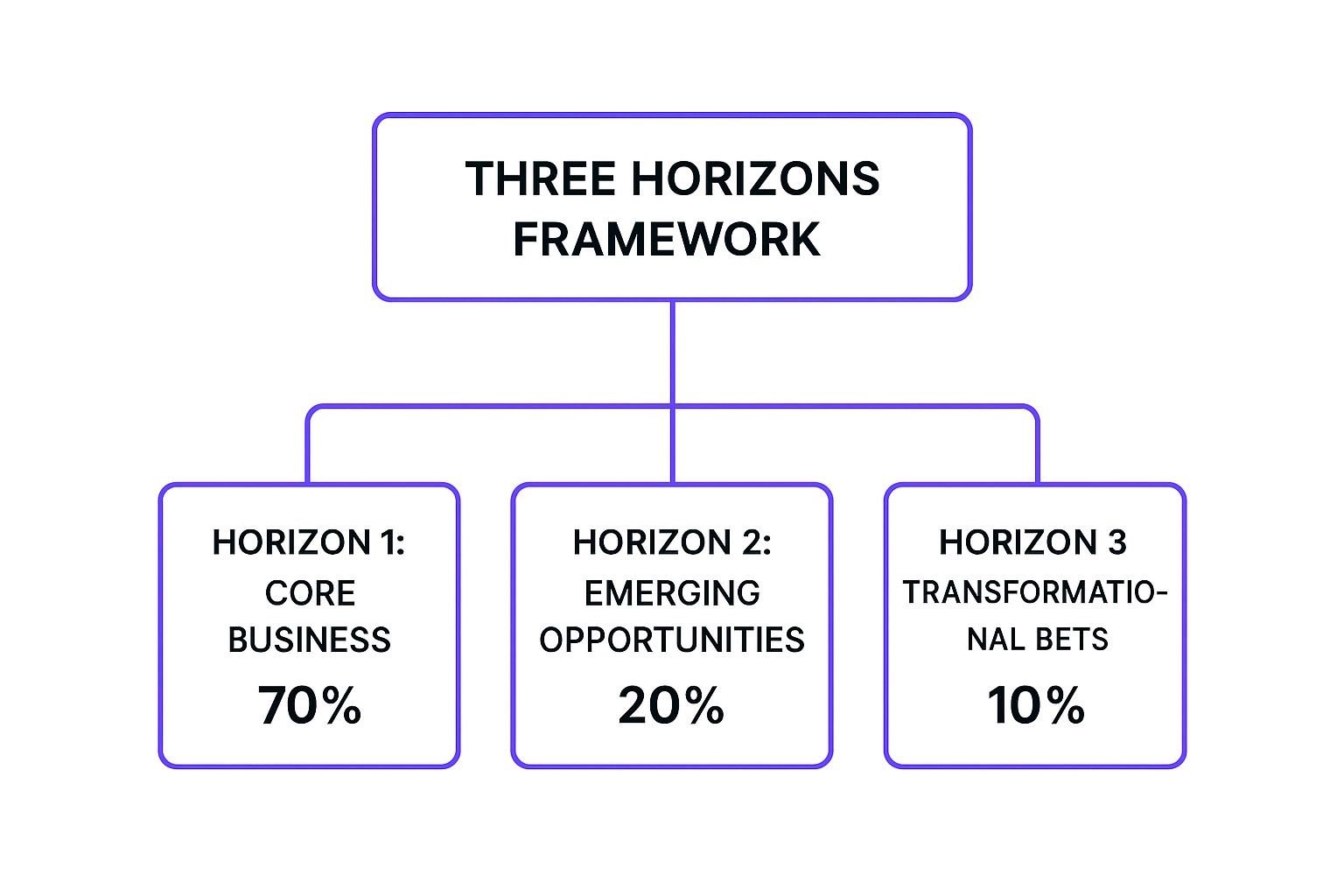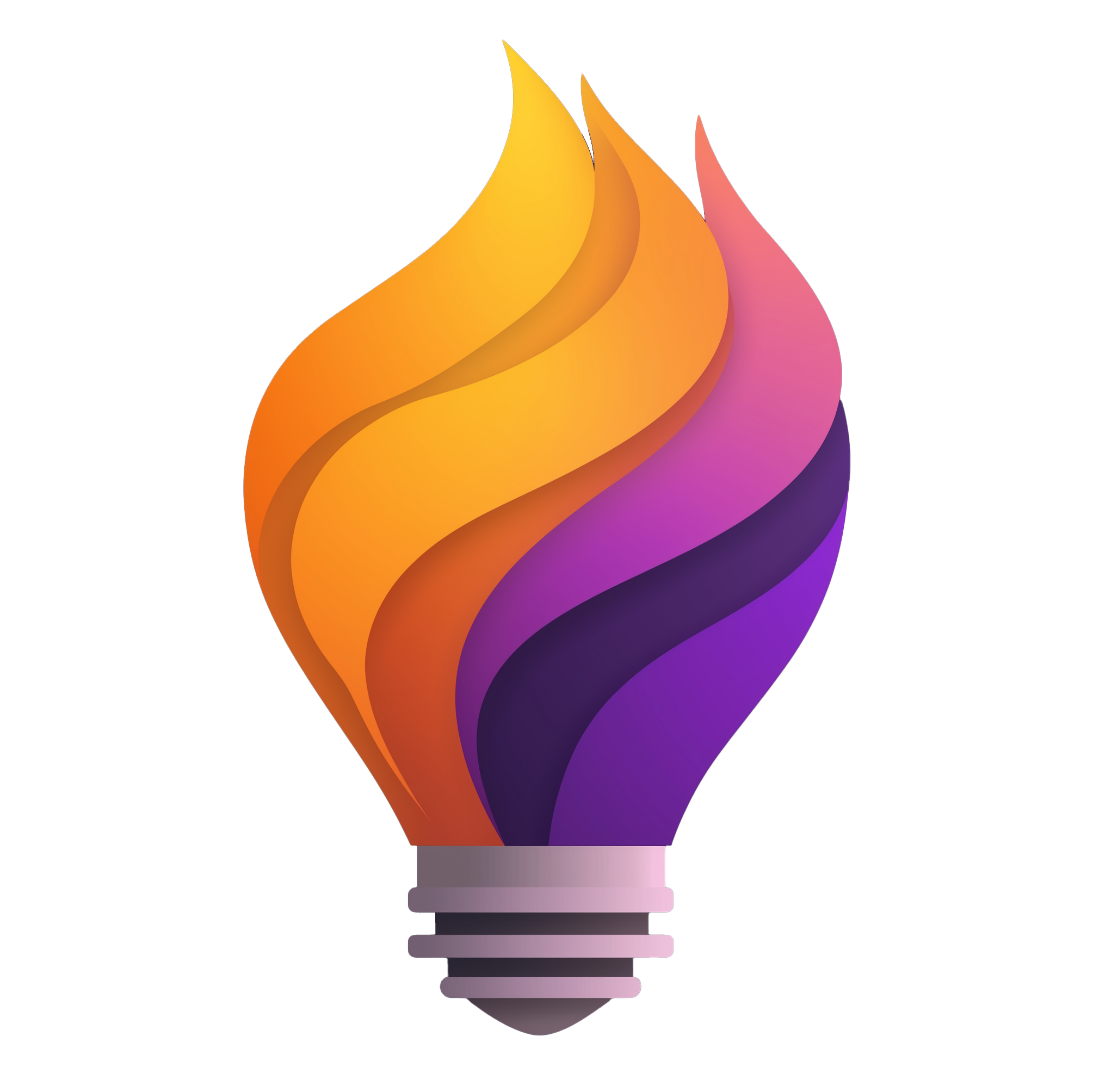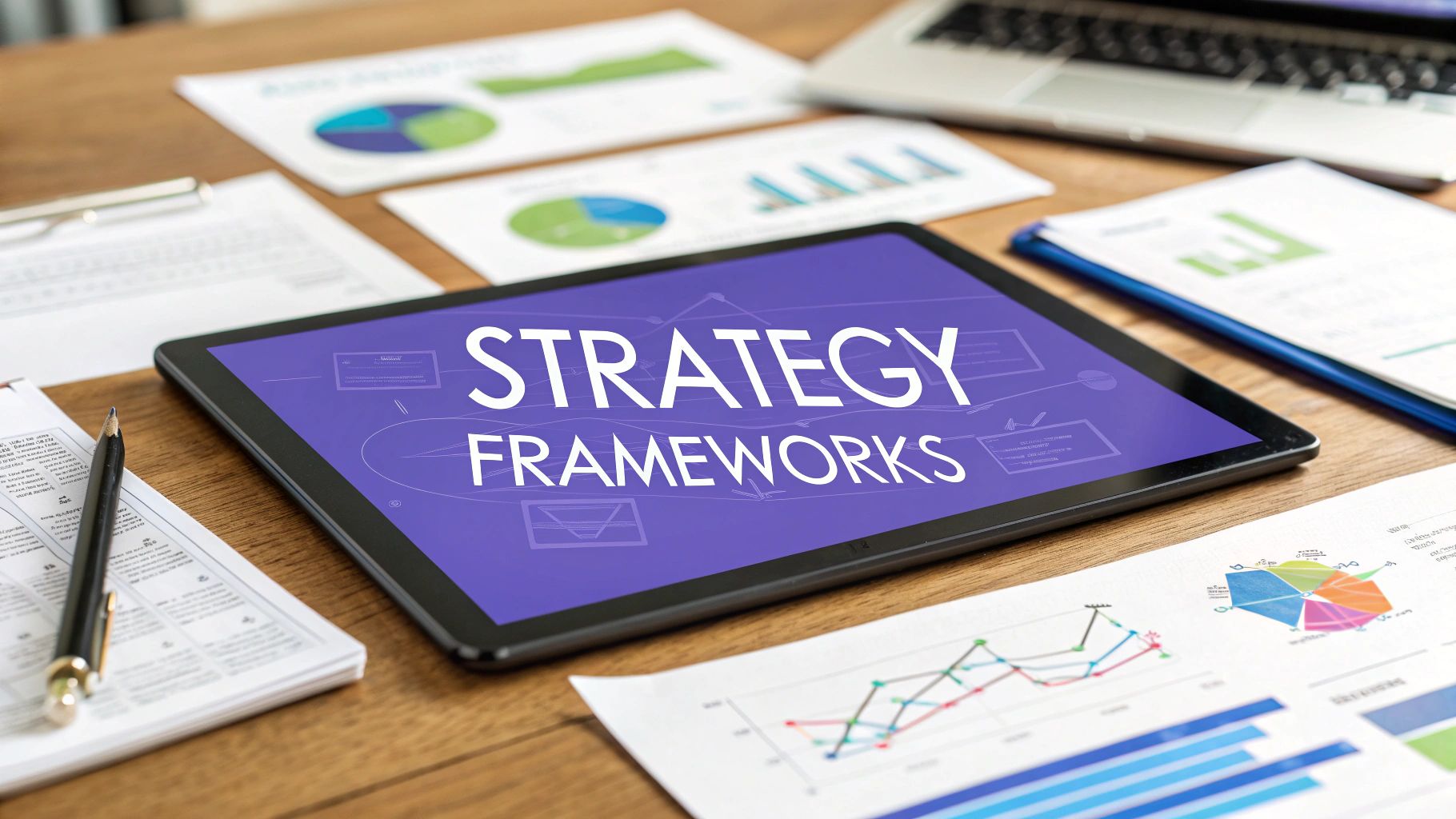Building a successful product isn't about having a great idea; it's about having a great plan. In a market where a high percentage of new products fail, a solid strategy is your most critical asset. It’s the compass that guides your team through the complexities of development, market changes, and customer needs. But how do you create a strategy that's both ambitious and actionable?
The answer lies in using proven product strategy frameworks. These structured models provide a systematic way to define your vision, align your team, and make data-driven decisions that lead to real-world success. Forget guessing games and gut feelings. This guide will walk you through 10 powerful frameworks, providing clear, actionable insights to help you choose the right one for your product.
We'll explore how each works, its unique strengths, and where it fits best, so you can stop just building features and start building a product that wins. For additional perspectives on business growth and product-related strategies, consider exploring resources like the Rebelgrowth Blog. Now, let's dive into the frameworks that can transform your product's trajectory.
1. Jobs-to-be-Done (JTBD) Framework
The Jobs-to-be-Done (JTBD) framework is a powerful lens for viewing your product strategy. It shifts the focus from customer demographics to the underlying "job" a customer is trying to accomplish. Instead of asking who your customers are, JTBD asks what they are trying to achieve in a given circumstance. This approach helps you understand the functional, social, and emotional motivations driving their choices.

Popularized by thought leaders like Clayton Christensen and Bob Moesta, this is one of the most insightful product strategy frameworks because it gets to the core of customer needs. For example, Intuit's TurboTax isn't just selling software; it's hired to do the job of "making tax filing simple and anxiety-free." Similarly, Airbnb is hired for the job of "finding an affordable and authentic place to stay while traveling."
How to Implement JTBD
- Conduct "switch" interviews: Talk to customers who recently switched to or from your product. Focus on the circumstances that triggered their decision and the entire journey they took.
- Identify the "job story": Frame the need using a simple structure: "When [situation], I want to [motivation], so I can [expected outcome]." This clarifies the context and desired result.
- Map the job's steps: Break down the entire process the customer goes through to complete their job, from start to finish, to identify pain points and opportunities for innovation.
When to Use This Framework
The JTBD framework is most effective when you are entering a crowded market or trying to understand why a current product's growth has stalled. It helps uncover unmet needs and identifies non-traditional competitors, giving you a fresh perspective to guide innovation and create solutions that customers will eagerly "hire."
2. North Star Framework
The North Star Framework helps product teams align around a single, powerful metric that represents the core value delivered to customers. This "North Star Metric" acts as a guiding light, ensuring that all product decisions, from small feature tweaks to major strategic shifts, contribute to a common goal. It provides a clear link between daily tasks and long-term customer value.

Popularized by growth expert Sean Ellis and companies like Amplitude, this is one of the most effective product strategy frameworks for driving focused growth. For example, Airbnb's North Star is "nights booked," which perfectly captures value for both guests and hosts. Similarly, for Facebook, "daily active users" long served as the metric that guided their product development to increase user engagement and retention.
How to Implement the North Star Framework
- Define your core value: Identify the one metric that best reflects customer success and your business objectives. It should measure customer value, not just revenue.
- Identify input metrics: Break down the North Star Metric into a set of contributing "input metrics" that individual teams can directly influence with their work.
- Connect work to the metric: Ensure all new initiatives, features, and experiments are designed to move one or more of the input metrics, and by extension, the North Star.
When to Use This Framework
The North Star Framework is ideal for companies seeking to scale growth and align cross-functional teams. It is particularly powerful for product-led growth (PLG) businesses where the product itself is the primary driver of customer acquisition and retention. Use it to eliminate silos, simplify complex decision-making, and create a shared understanding of what success looks like across the entire organization.
3. Product-Market Fit Framework
The Product-Market Fit (PMF) framework is a critical milestone for any product strategy, defining the point where a product successfully satisfies strong market demand. It’s the sweet spot where your solution resonates so deeply with a target market that customers not only pay for it but also become advocates, driving organic growth. This concept is less a rigid process and more a state of being that every startup strives to reach.
Coined by Marc Andreessen and popularized by thinkers like Sean Ellis and Eric Ries, PMF is one of the most fundamental product strategy frameworks because it validates that you've built something people truly want. Slack, for example, achieved this by creating a communication tool that solved the chaos of internal emails for tech teams. Similarly, Dropbox found PMF by offering a dead-simple solution for file sharing when other options were clunky and complex.
How to Implement the Product-Market Fit Framework
- Use the 40% rule: Survey your users and ask how they would feel if they could no longer use your product. If at least 40% say they would be "very disappointed," you have a strong signal of PMF.
- Track retention cohorts: Analyze user retention over time. High and flattening retention curves indicate that customers find ongoing value in your product.
- Monitor organic growth: Pay close attention to word-of-mouth referrals and organic sign-ups. When customers are bringing in new customers without prompting, you're on the right track.
When to Use This Framework
The PMF framework is essential during the early stages of a product's lifecycle, before you scale marketing and sales efforts. It helps you avoid the common pitfall of pouring resources into a product that the market doesn't need. Understanding and achieving this fit is paramount, and you can explore a detailed guide on how to achieve Product-Market Fit for more specific tactics. Use this framework to guide your pivots and iterations until your metrics show that you've truly connected with your customers' needs.
4. OKRs (Objectives and Key Results)
OKRs (Objectives and Key Results) is a goal-setting framework that connects ambitious company goals to the measurable actions of teams and individuals. An Objective is a memorable, qualitative description of what you want to achieve, while Key Results are the specific, quantitative metrics that measure your progress toward that Objective. This framework fosters transparency, focus, and alignment across the entire organization.
Popularized by John Doerr and famously adopted by companies like Intel and Google, OKRs are one of the most effective product strategy frameworks for turning long-term vision into short-term, actionable plans. For example, a product team might set an Objective to "Delight our new users." Key Results could include "Achieve a 90% user satisfaction score on the onboarding survey" and "Increase week-one retention from 25% to 40%."
How to Implement OKRs
- Define ambitious Objectives: Set 3-5 high-level, inspirational goals for a given cycle, typically a quarter. These should be motivating and aligned with broader company strategy.
- Establish measurable Key Results: For each Objective, create 3-4 specific, time-bound, and measurable outcomes. Focus on results, not activities (e.g., "achieve 15% user growth" instead of "launch three marketing campaigns").
- Conduct regular check-ins: Review progress weekly or bi-weekly. This isn't for judging performance but for identifying obstacles and adjusting tactics as needed.
- Score and reflect: At the end of the cycle, score your Key Results (a common practice is a scale of 0 to 1, where 0.7 is considered a success for stretch goals) and reflect on what was learned.
When to Use This Framework
OKRs are ideal when you need to align autonomous teams toward a unified strategy or accelerate growth by setting ambitious "moonshot" goals. It excels at translating high-level annual plans into concrete quarterly execution, ensuring everyone is moving in the same direction. Successfully implementing OKRs involves a robust process for aligning priorities and incentives within an annual plan to ensure organizational coherence.
You can learn more about goal-setting frameworks on RemoteSparks.com to see how OKRs compare to other methods.
5. Design Thinking Framework
Design Thinking is a human-centered approach to innovation that integrates the needs of people, the possibilities of technology, and the requirements for business success. It's an iterative, non-linear process focused on deeply understanding users, challenging assumptions, and redefining problems to identify alternative strategies and solutions. This framework is less about a rigid formula and more about a mindset of creative problem-solving.
Popularized by IDEO and the Stanford d.school, Design Thinking is one of the most collaborative product strategy frameworks because it puts the end-user at the heart of the creation process. For example, Bank of America's "Keep the Change" program was born from observing customers' difficulties with saving money. By rounding up debit card purchases and transferring the difference to savings, they created a solution that directly addressed a real-world user struggle.
How to Implement Design Thinking
- Empathize and Define: Invest significant time in user research through observation and interviews to gain a deep understanding of their needs. Then, synthesize this information to define a core problem statement.
- Ideate and Prototype: Brainstorm a wide range of creative solutions without judgment. Build quick, low-fidelity prototypes (like sketches or wireframes) to make your ideas tangible and testable.
- Test and Iterate: Share your prototypes with users to gather feedback. Use these insights to refine your solutions or even pivot your approach, embracing failure as a critical part of the learning cycle. To dig deeper, you can learn more about the Design Thinking process.
When to Use This Framework
Design Thinking is exceptionally powerful when tackling complex, ambiguous, or poorly defined problems where the path forward isn't clear. It is ideal for driving innovation in new products, redesigning existing user experiences, or improving internal processes. Use it when you need to break away from incremental improvements and generate truly novel solutions grounded in genuine user needs.
6. Lean Startup Methodology
The Lean Startup Methodology, popularized by Eric Ries, offers a scientific approach to creating and managing startups and getting a desired product to customers' hands faster. It's built on the principle of validated learning, which means treating your product strategy as a series of experiments. Instead of lengthy upfront planning, the focus is on a continuous cycle of building, measuring, and learning.
This is one of the most action-oriented product strategy frameworks because it prioritizes speed and customer feedback over perfection. The core idea is to launch a minimum viable product (MVP) to test a core hypothesis. For example, Dropbox famously started with a simple explainer video (an MVP) to gauge interest before building the complex backend infrastructure. This allowed them to validate demand with minimal investment.
How to Implement the Lean Startup Methodology
- Define clear hypotheses: Before building anything, state your assumptions as testable hypotheses. For example, "We believe that customers will pay for a service that automates social media scheduling."
- Build an MVP: Create the smallest possible version of your product that allows you to test your primary hypothesis. This could be a landing page, a video, or a single-feature app.
- Measure and learn: Use analytics to track user behavior and gather direct feedback. Focus on actionable metrics that prove or disprove your hypothesis, not vanity metrics.
- Pivot or persevere: Based on the data, decide whether to continue with your current strategy (persevere) or make a fundamental change to your product, strategy, or growth engine (pivot).
When to Use This Framework
The Lean Startup Methodology is ideal for early-stage ventures operating under conditions of extreme uncertainty. It's also highly effective for established companies launching new products in unknown markets. Use this framework when you need to validate a business idea quickly, minimize waste, and ensure you're building something people actually want before committing significant resources.
7. RICE Prioritization Framework
The RICE scoring model is a prioritization framework designed to help product managers make more objective decisions about what to work on next. It forces teams to quantify the potential value of features or initiatives by scoring them against four key factors: Reach, Impact, Confidence, and Effort. This method removes gut feelings from the equation, providing a clear, data-informed score for each idea.

Popularized by the team at Intercom, RICE is one of the most practical product strategy frameworks for roadmap planning. The final score is calculated by multiplying Reach, Impact, and Confidence, then dividing the total by Effort (R x I x C / E). For instance, a high-impact feature reaching thousands of users with low effort will score much higher than a low-impact feature requiring significant development time.
How to Implement RICE
- Quantify Reach: Estimate how many customers will be affected by the feature within a specific timeframe (e.g., users per quarter). Use product analytics for accuracy.
- Define Impact: Score the expected impact on a scale (e.g., 3 for massive, 2 for high, 1 for medium, 0.5 for low). This helps standardize how you measure value.
- Assess Confidence: Assign a percentage to how confident you are in your Reach and Impact estimates (e.g., 100% for high confidence, 80% for medium, 50% for low).
- Estimate Effort: Calculate the total time required from all teams (product, design, engineering) in "person-months" or another consistent unit.
When to Use This Framework
RICE is ideal when you face a long backlog of competing ideas and need a disciplined way to prioritize. It is especially useful for established products where data is available to make informed estimates on reach and impact. The framework helps align stakeholders by creating a transparent and logical system for making tough trade-offs, ensuring resources are focused on the initiatives that will deliver the most value. You can explore a similar approach with a prioritization matrix template from remotesparks.com.
8. Value Proposition Canvas
The Value Proposition Canvas is a strategic tool that helps you achieve product-market fit by visualizing the relationship between your customer's needs and your product's features. It breaks down the customer profile into their jobs, pains, and gains, and maps these directly to your product's value proposition, which includes pain relievers and gain creators. This visual alignment ensures you are building something people actually want.
Developed by Alexander Osterwalder as a companion to the Business Model Canvas, this is one of the most practical product strategy frameworks for designing and testing value propositions. For example, Slack’s value proposition directly addresses the customer pain of "too many emails" and the job of "team communication" by offering a centralized, searchable platform that creates the gain of "increased productivity."
How to Implement the Value Proposition Canvas
- Map the customer profile: Start by deeply understanding your customer. List their "jobs" (what they're trying to do), "pains" (frustrations and obstacles), and "gains" (desired outcomes and benefits).
- Design the value map: For each customer pain, identify a "pain reliever" your product offers. For each gain, define a "gain creator." List all products and services that deliver these.
- Achieve fit: Constantly validate the connections between your value map and the customer profile. Are your pain relievers addressing significant pains? Are your gain creators producing relevant gains?
When to Use This Framework
The Value Proposition Canvas is indispensable when developing a new product, entering a new market segment, or refining an existing product's messaging and features. Use it in the early stages to validate your core assumptions and ensure you are solving a meaningful problem for a specific customer group, preventing you from building a solution in search of a problem.
9. Hook Model Framework
The Hook Model is a four-step framework designed to build habit-forming products by creating powerful user engagement loops. It focuses on the psychology behind user behavior, guiding them through a cycle that, over time, connects their internal triggers (like boredom or loneliness) to your product. This model helps create products that users turn to automatically without conscious thought.
Developed by Nir Eyal in his book Hooked, this is one of the most powerful product strategy frameworks for products that rely on high user engagement. For instance, the Instagram feed pulls you in with a notification (Trigger), you scroll (Action), discover new content (Variable Reward), and then like or comment (Investment), which strengthens your connection to the app. Similarly, Duolingo uses streaks and daily goals to hook users into a language-learning habit.
How to Implement the Hook Model
- Identify Triggers: Determine the external cues (notifications, emails) and internal triggers (emotions, routines) that prompt users to action. The goal is to eventually link your product to an internal trigger.
- Simplify the Action: Make the intended action as simple as possible. Think of the "infinite scroll" on social media or a one-click "play" button. The less friction, the better.
- Design Variable Rewards: Create rewards that are fulfilling but unpredictable. This could be social validation (likes), new information (news feeds), or personal achievement (game levels). The variability is key to keeping users engaged.
- Encourage Investment: Ask users to put something of value into the product, such as data, time, or social capital. This could be building a profile, following friends, or creating a playlist. Investments make the product more valuable and increase the likelihood of a return visit.
When to Use This Framework
The Hook Model is most effective for products that require high frequency of use, such as social media, gaming, media consumption, or productivity apps. It’s ideal when your business model depends on user retention and engagement rather than one-time transactions. Use it to design features that integrate seamlessly into a user's daily routine and build long-term loyalty.
10. Three Horizons Framework
The Three Horizons Framework is a strategic planning tool that helps organizations manage and balance their innovation efforts across different time horizons. Developed by McKinsey & Company, it ensures that companies can maintain their current business performance while simultaneously investing in future growth engines. The framework divides initiatives into three categories: optimizing the core business, scaling emerging opportunities, and exploring disruptive, long-term innovations.
This model is one of the most essential product strategy frameworks for established companies seeking sustained growth. For example, Google manages its core Search business (Horizon 1), grows its Cloud platform (Horizon 2), and invests in long-term bets like quantum computing (Horizon 3). This balanced approach prevents companies from becoming too focused on short-term gains at the expense of future viability.
The infographic below illustrates the recommended allocation of resources across the three horizons.

This visual breakdown highlights how the majority of resources protect the core business, while smaller, dedicated portions fuel future growth and transformation.
How to Implement the Three Horizons Framework
- Categorize initiatives: Audit all current and potential projects and assign them to one of the three horizons based on their timeline and risk profile.
- Allocate resources: Follow a balanced investment strategy, such as the 70-20-10 rule: 70% of resources go to Horizon 1, 20% to Horizon 2, and 10% to Horizon 3.
- Set distinct metrics: Use different success metrics for each horizon. Horizon 1 should focus on profitability and market share, while Horizon 3 should be measured by learning milestones and validated assumptions.
When to Use This Framework
The Three Horizons Framework is ideal for mature organizations looking to structure their innovation portfolio and avoid being disrupted. It provides a clear, strategic map for allocating capital and talent to initiatives that will both defend the present and create the future. It is particularly useful for leadership teams aiming to build a culture of continuous innovation without neglecting their core revenue streams.
Product Strategy Frameworks Comparison Matrix
| Framework | Implementation Complexity 🔄 | Resource Requirements ⚡ | Expected Outcomes 📊 | Ideal Use Cases 💡 | Key Advantages ⭐ |
|---|---|---|---|---|---|
| Jobs-to-be-Done (JTBD) | Moderate to High (deep customer research, journey mapping) | High (extensive interviews, analysis) | Better product-market fit, uncover unmet needs | Customer motivation exploration, innovation | Deep customer insights, reduces feature bloat |
| North Star Framework | Moderate (metric selection and alignment) | Moderate (data tracking systems) | Strong organizational alignment, focused growth | Metric-driven product strategy, cross-team focus | Simplifies decisions, clear success measurement |
| Product-Market Fit Framework | Moderate to High (iterative validation, market research) | Moderate to High (customer validation efforts) | Validation of market demand, prioritization | Early product-market validation, investor readiness | Reduces risk, data-driven product decisions |
| OKRs (Objectives and Key Results) | Moderate (goal setting and tracking processes) | Moderate (management overhead) | Organizational alignment, measurable progress | Company-wide goal alignment, accountability | Encourages ambitious goals, transparency |
| Design Thinking Framework | High (non-linear, iterative process with prototypes) | High (cross-functional collaboration) | Innovative solutions, user-centered products | Complex problem solving, UX design | Deep user understanding, creative solutions |
| Lean Startup Methodology | Moderate to High (build-measure-learn loops) | Moderate (rapid experimentation) | Rapid learning, risk minimization | Startups, early-stage products | Minimizes waste, data-driven pivots |
| RICE Prioritization Framework | Low to Moderate (scoring and estimation) | Low to Moderate (team estimation effort) | Objective feature prioritization | Feature prioritization, roadmap planning | Data-driven, reduces bias |
| Value Proposition Canvas | Moderate (customer and value mapping) | Moderate to High (customer research) | Clear product-market fit, value alignment | Product strategy, marketing alignment | Visual tool, uncovers market gaps |
| Hook Model Framework | Moderate (designing engagement loops) | Moderate (psychological insights) | High user engagement and retention | Habit-forming digital products | Increases retention, boosts customer lifetime value |
| Three Horizons Framework | High (strategic resource allocation and management) | High (multi-horizon coordination) | Balanced innovation and core business performance | Long-term innovation portfolio management | Balances present and future innovation |
Choosing Your Framework and Taking Action
We've explored a wide range of powerful product strategy frameworks, from the customer-centric focus of Jobs-to-be-Done to the ambitious, future-gazing lens of the Three Horizons Model. Navigating these options can feel like choosing a single tool from a packed toolbox. The most critical takeaway is that there is no one-size-fits-all solution; the perfect framework is a myth.
The best framework is the one that aligns with your unique context. Your company's stage, team culture, market maturity, and immediate challenges are the real determinants of which tool to pull out first. Your goal shouldn't be to master and rigidly adopt a single model. Instead, aim for strategic agility by understanding the core principles behind each one.
From Theory to a Tailored Strategy
The true power of these frameworks is unlocked when you start mixing and matching them to build a system that works for you. This approach allows you to create a more robust and customized product strategy.
Consider these hybrid approaches:
- For Innovation & Alignment: Combine the Jobs-to-be-Done (JTBD) framework with the North Star Framework. Use JTBD interviews to deeply understand the "job" your customers are hiring your product for. This insight will help you define a truly meaningful North Star Metric that reflects real customer value, not just a vanity metric.
- For Prioritization & Execution: Integrate the RICE Prioritization Framework directly into your OKRs. When you set an ambitious Objective and define your Key Results, you will inevitably generate a long list of potential initiatives. Use RICE to systematically score and rank these initiatives, ensuring your team focuses its energy on the projects with the highest potential impact.
- For Validation & Growth: Pair the Lean Startup Methodology with the Value Proposition Canvas. Use the canvas to articulate your hypotheses about customer pains, gains, and jobs. Then, apply the Build-Measure-Learn loop of the Lean Startup to test those hypotheses with a Minimum Viable Product (MVP), gathering real-world data to validate your direction.
Your Actionable Next Steps
Mastering product strategy is an ongoing journey, not a destination. The key is to move from passive learning to active implementation. Don't let analysis paralysis set in.
Here is a simple plan to get started:
- Start the Conversation: Share this article with your team. Discuss which frameworks resonate most and why. A shared understanding is the first step toward strategic alignment.
- Identify Your Core Challenge: What is the biggest strategic problem you need to solve right now? Is it a lack of focus? Difficulty with prioritization? A dry pipeline of new ideas? Your answer will point you toward the most relevant framework.
- Run a Pilot: Select one framework and commit to using it for a single quarter or project. Treat it as an experiment. Document what works, what doesn't, and what you learned.
- Reflect and Adapt: At the end of your pilot, gather the team to review the process. Was it helpful? Did it lead to better decisions? Based on your findings, decide whether to continue, modify the approach, or try a different framework.
By moving from theory to practice, you begin building the muscle memory for strategic thinking. The consistent application of these product strategy frameworks will transform your team from being reactive to proactive, empowering you to build products that not only delight customers but also drive sustainable business growth.
Ready to put these frameworks into action but need a structured way to guide your team's creativity? Bulby provides AI-powered, guided brainstorming sessions to help you effectively apply strategic models like JTBD and Design Thinking. Turn abstract concepts into concrete, actionable ideas by visiting Bulby and start your first innovation sprint today.

